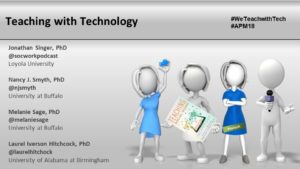#APM18 Teaching with Technology using the SAMR Model
 On Thursday, November 8, 2018, I will be presenting with Jonathan Singer, Melanie Sage & Nancy J. Smyth the Teaching Institute for Early Career Faculty at the Council on Social Work Education’s 2018 Annual Program Meeting. In this session, we are focusing on how faculty can incorporate technology into a social work course. All educators, especially those early in their careers, find themselves teaching from syllabi they had no role in developing. Although there are many benefits to the “hand-me-down” syllabus, one of the limitations is that assignments are rarely updated to reflect the realities of the 21st century workplace, which now includes the use of technology to achieve practice outcomes for clients and organizations. The purpose of this workshop is to learn about how to incorporate the use technology into a social work assignment on your syllabus, using Puentedura’s SAMR Module for Technology Integration. We will provide a brief overview of teaching with technology before focusing on how to infuse technology into an assignment from your syllabus, including learning objectives and associated assessment techniques in your syllabus. Participants will learn to identify ways to substitute, augment, modify or redefine existing learning strategies and assignments with technology-mediated learning strategies and assignments. By the end of the session, the participant will have an assignment that uses technology to meet the learning needs identified in the syllabus.
On Thursday, November 8, 2018, I will be presenting with Jonathan Singer, Melanie Sage & Nancy J. Smyth the Teaching Institute for Early Career Faculty at the Council on Social Work Education’s 2018 Annual Program Meeting. In this session, we are focusing on how faculty can incorporate technology into a social work course. All educators, especially those early in their careers, find themselves teaching from syllabi they had no role in developing. Although there are many benefits to the “hand-me-down” syllabus, one of the limitations is that assignments are rarely updated to reflect the realities of the 21st century workplace, which now includes the use of technology to achieve practice outcomes for clients and organizations. The purpose of this workshop is to learn about how to incorporate the use technology into a social work assignment on your syllabus, using Puentedura’s SAMR Module for Technology Integration. We will provide a brief overview of teaching with technology before focusing on how to infuse technology into an assignment from your syllabus, including learning objectives and associated assessment techniques in your syllabus. Participants will learn to identify ways to substitute, augment, modify or redefine existing learning strategies and assignments with technology-mediated learning strategies and assignments. By the end of the session, the participant will have an assignment that uses technology to meet the learning needs identified in the syllabus.
What is the SAMR Model for Technology Integration?
Ruben Puentedura’s SAMR Model for Technology Integration uses hierarchical levels of technology adaptation that range from using technology to enhance an assignment at the lowest end of the spectrum to incorporating technology in such a way that the learning activity is transformed into something new at the highest end. Using this model, a social work assignment can be adapted at any level of the model by simply replacing a one traditional educational tool like a class role play, for another tool, such as a Youtube video of a role play. Other modifications change the assignment entirely and push students toward higher levels of thinking needed for digital literacy. For example, a traditional literature review changes from a written paper to a podcast assignment that not only outlines an important research topic, but now requires an informational interview with a leading social work scholar. The SAMR model can help social work educators reflect and evaluate how they are incorporating technology into a seated or hybrid classroom, across a range of assignments and activities. Benefits of the SAMR Model include: 1) the promotion of digital literacy throughout the transformation of assignments and learning activities; 2) the gradual inclusion of technology into a class assignment over time, giving the educator the opportunity to pilot test new technology tools and to experiment with an assignment from semester to semester; and 3) allows the educator to scaffold their assignment, a process where the instructor includes guidance, support, and advice early on during an assignment or activity, and then slowly removes the supports so that students can practice and learn on their own.
Here are the slides to the session:
Teaching with Technology from Laurel Hitchcock
Additionally, you can access a digital copy of a worksheet that will help you to integrate technology into your assignment: https://drive.google.com/file/d/1fd2WXHsn-7pUGQko1SBFepP2OOL4tL9i/view?usp=sharing
How have you incorporated technology into your social work assignments? Please leave a comment and let us know how you have update your course syllabus or assignment with technology.
How to cite this blog post:
Hitchcock, L.I., Singer, J., Sage, M. & Smyth, N. (2018, November 8). #APM18 Teaching with Technology with the SAMR Model [Blog Post]. Retrieved from: https://laureliversonhitchcock.org/2018/11/07/apm18-teaching-with-technology-with-the-samr-model/


